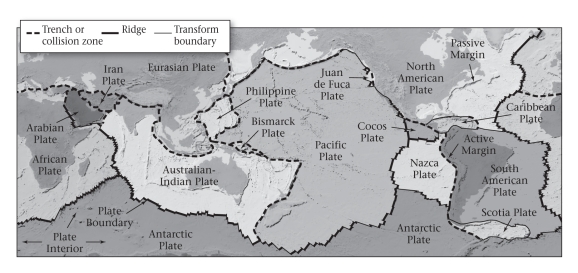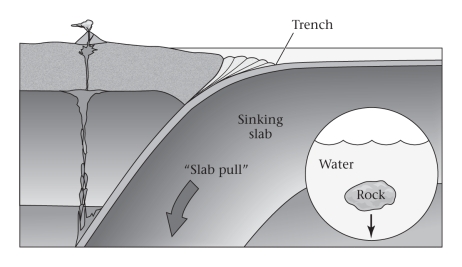A) less mafic,and therefore less dense,than surrounding asthenosphere
B) cooler,and therefore more dense,than surrounding asthenosphere
C) hotter,and therefore more dense,than surrounding asthenosphere
D) cooler,and therefore less dense,than surrounding asthenosphere
F) All of the above
Correct Answer

verified
Correct Answer
verified
Multiple Choice
Tectonic plates move at rates that are approximately ____________.
A) 1 to 5 cm every 1,000 years
B) 1 to 15 cm/year
C) 1 to 15 m/year
D) 10 to 100 m/year
F) A) and C)
Correct Answer

verified
Correct Answer
verified
Multiple Choice
Within the terminology of plate tectonics,an active margin is ____________.
A) synonymous with "subduction zone"
B) a 5-mile radius surrounding an active volcano
C) a continental coastline that coincides with a plate boundary
D) anywhere on Earth where earthquakes are especially frequent
F) C) and D)
Correct Answer

verified
Correct Answer
verified
Multiple Choice
Unlike the lithosphere,the asthenosphere ____________.
A) is able to flow over long periods of time
B) has a density similar to the core
C) varies in thickness from place to place
D) is relatively cool
F) All of the above
Correct Answer

verified
Correct Answer
verified
Multiple Choice
According to the figure below,every plate boundary can be recognized by ____________.

A) the presence of active volcanoes
B) the presence of an earthquake belt
C) a deep chasm that can be seen from space
D) None of the above are correct.
F) None of the above
Correct Answer

verified
Correct Answer
verified
Multiple Choice
At transform plate boundaries ____________.
A) earthquakes are common but volcanoes are absent
B) volcanoes are common but earthquakes do not occur
C) both earthquakes and volcanoes are common
E) A) and B)
Correct Answer

verified
Correct Answer
verified
Multiple Choice
The mid-ocean ridges are elevated above the surrounding sea floor because ____________.
A) ridge rocks are hot and therefore of relatively low density
B) the lithospheric plates are thickest at the ridges so they stand up taller
C) rising ocean currents leave a vacuum above the ridge
D) ridge rocks are mafic,whereas the ocean basin crust consists of ultramafic rock
F) All of the above
Correct Answer

verified
Correct Answer
verified
Multiple Choice
Iceland is one of the few places in the world that is both above sea level and situated atop a ____________ plate boundary.
A) convergent
B) divergent
C) transform
E) A) and C)
Correct Answer

verified
Correct Answer
verified
Multiple Choice
Broad,sediment-covered continental shelves are found along ____________.
A) active margins
B) passive margins
D) undefined
Correct Answer

verified
Correct Answer
verified
Multiple Choice
The rate of motion of a lithospheric plate with respect to a stationary hot spot is termed ____________.
A) relative plate velocity
B) absolute plate velocity
D) undefined
Correct Answer

verified
Correct Answer
verified
Multiple Choice
Continental lithosphere ____________.
A) is thicker than oceanic lithosphere
B) contains more mafic rocks than oceanic lithosphere
C) is denser than oceanic lithosphere
D) contains no crustal material,consisting solely of lithified upper mantle
F) A) and B)
Correct Answer

verified
Correct Answer
verified
Multiple Choice
Summed over the entire surface of Earth,____________.
A) the rate of lithospheric production at ridges is greater than the rate of lithospheric consumption at subduction zones
B) the rate of lithospheric consumption at subduction zones is greater than the rate of lithospheric production at ridges
C) rates of lithospheric production and consumption are equal
E) A) and C)
Correct Answer

verified
Correct Answer
verified
Multiple Choice
Consult the figure below.Most of the pulling force driving plate motion is produced ____________.

A) at mid-ocean ridges
B) at subduction zones
C) at collision zones
D) in the interiors of continental plates
F) A) and C)
Correct Answer

verified
Correct Answer
verified
Multiple Choice
The youngest sea floor occurs ____________.
A) along passive margins
B) along active margins
C) along mid-ocean ridges
D) randomly over the entire ocean basin
F) A) and B)
Correct Answer

verified
Correct Answer
verified
Multiple Choice
Hot spots are caused by ____________.
A) friction due to the lithosphere sliding atop the asthenosphere
B) unusually dense concentrations of radioactive isotopes at various points in the crust
C) hot plumes of mantle material that rises up through cooler,denser surrounding rock
D) factors that remain completely unknown at this time
F) B) and C)
Correct Answer

verified
Correct Answer
verified
Multiple Choice
Deformed (bent,stretched,or cracked) lithosphere occurs ____________.
A) randomly over the surface of Earth
B) primarily within the interiors of tectonic plates
C) primarily on the margins of tectonic plates
E) All of the above
Correct Answer

verified
Correct Answer
verified
Multiple Choice
At a subduction zone,the overriding plate ____________.
A) is always composed of continental lithosphere
B) is always composed of oceanic lithosphere
C) may be composed of either oceanic or continental lithosphere
E) A) and C)
Correct Answer

verified
Correct Answer
verified
Multiple Choice
When two bodies of continental lithosphere are pulled together at a convergent boundary,the result is ____________.
A) subduction
B) collision and mountain formation
D) undefined
Correct Answer

verified
Correct Answer
verified
True/False
Subducted slabs have never been detected below the Wadati-Benioff zone.
B) False
Correct Answer

verified
Correct Answer
verified
Multiple Choice
As compared to a slowly spreading mid-ocean ridge,a rapidly spreading ridge is ____________.

A) wider
B) narrower
C) more silicic in lava composition
E) All of the above
Correct Answer

verified
Correct Answer
verified
Showing 21 - 40 of 64
Related Exams